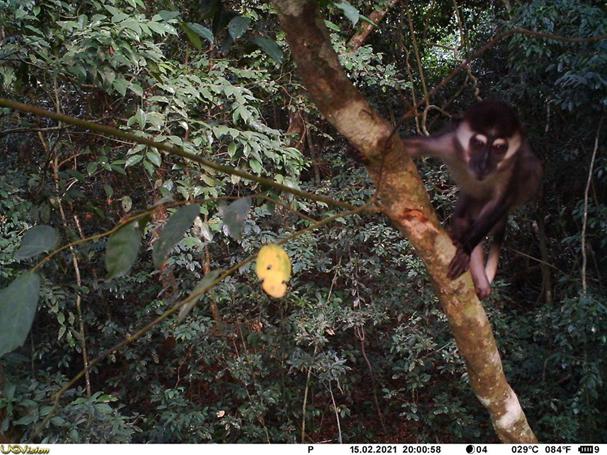Fasona Michelle
This project proposes to use camera traps to survey arboreal mammals at Omo Forest Reserve, Nigeria. Arboreal mammals within Omo Forest Reserve are threatened by human activities, e.g. farming. But the degree that these activities impact arboreal mammals are unknown because most surveys use forest floor visual observation. The project aims to first, use camera traps to improve detection propensity and increase survey sensitivity of arboreal mammals. Second, use dynamic occupancy models to evaluate the impacts of human activities on arboreal mammals. Lastly, implement an environmental education program for Omo communities to inspire more conservation minded land use practices.

Red Capped Mangabey (Cercocebus torquatus)
This project chose to study arboreal mammal occupancy in Omo Forest Reserve, Nigeria-hereafter Omo, for two reasons. First, Omo is an important biodiversity hotspot of southwest Nigeria (Oates et al., 2008), and is home to numerous IUCN listed species such as the red-capped mangabey (Cercocebus torquatus) and the Nigerian white-throated monkey (Cercopithecus erythrogaster; Fasona et al., 2018). Second, arboreal mammals can be considered an indicator species for intact and pristine forests as they are sensitive to human disturbance (Whitworth et al., 2019). Additionally, conservation of arboreal mammals may provide conservation benefits for numerous other species as they are an umbrella species for tropical forest ecosystem conservation (Gregory et al., 2017).
Previous Omo arboreal mammal studies have suffered from low detection rates, likely because previous studies utilized traditional forest floor survey techniques (Fasona et al., 2018; Orimaye et al., 2017). Our study improves upon previous efforts by utilizing camera traps placed ~10m above the ground, which is where arboreal mammals live (Whitworth et al., 2016; Bowler et al., 2017). Previous studies found camera traps to be an effective technique for detecting diurnal, nocturnal, elusive, and cryptic species (Gregory et al., 2014; Gregory et al., 2017; Bowler et al., 2017). Our use of camera traps will further improve upon past efforts by allowing us to continuously survey remote areas of Omo Forest throughout the rainy season. Previous research efforts have not been able to survey large tracts of Omo Forest during the rainy season because the forest can become inaccessible for traditional surveys
We organise our research around 4 core objectives:
(1) Estimate Omo arboreal mammal population abundance and distribution.
(2) Geo-spatial mapping of arboreal mammal occupancy.
(3) Model environmental attributes driving arboreal mammal species occupancy.
(4) Develop and implement an environmental education program to inspire arboreal mammal and forest conservation and improved forest patrol monitoring.
The project will culminate with a set of specific and practical activities for preserving forest arboreal mammal populations and habitat.